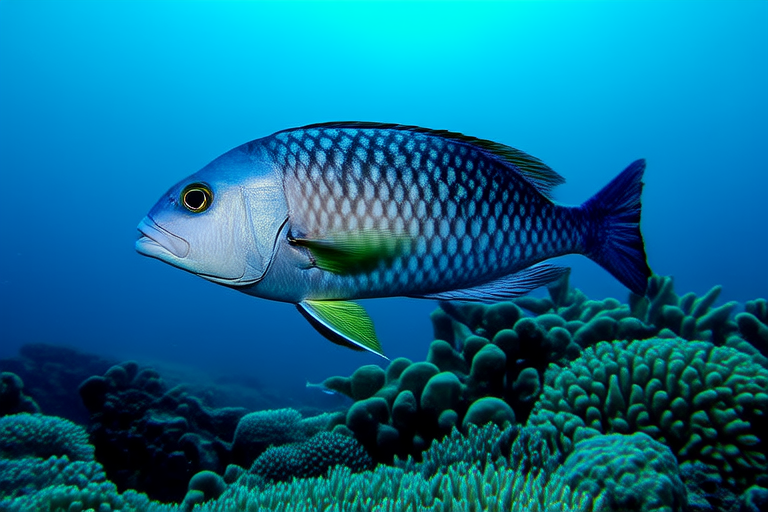Top 10 Fascinating Facts About Parrot Fish That Will Blow Your Mind
Parrotfish, with their vibrant colors and intriguing behaviors, are among the most captivating inhabitants of coral reefs. These fish play a crucial role in maintaining the health of marine ecosystems, and their unique traits make them stand out in the underwater world. From their striking appearance to their fascinating biological processes, here are ten mind-blowing facts about parrotfish that will deepen your appreciation for these extraordinary creatures.
1. A Rainbow of Colors
Parrotfish come in an array of stunning hues, ranging from electric blues and greens to fiery oranges and pinks. Their bright coloration serves multiple purposes, including camouflage against predators and attracting mates. The vivid pigmentation can change depending on the fish’s age, sex, and social status, making each individual unique. This remarkable ability to alter their appearance underscores the complexity of parrotfish behavior and their adaptation to their environment.
2. Teeth Like a Beak
The name “parrotfish” is aptly chosen, as these fish possess beak-like teeth designed for grinding and scraping algae off rocks and coral. Their strong jaws allow them to break down hard surfaces, contributing significantly to the maintenance of coral reefs. Interestingly, their teeth grow continuously throughout their lives, ensuring they always have sharp tools for feeding. This unique dental structure highlights the specialized adaptations of parrotfish for their ecological niche.
3. Sleeping in a Cocoon
One of the most fascinating aspects of parrotfish is their sleeping habits. Before resting, they secrete a mucus cocoon around themselves, creating a protective barrier against predators and parasites. This nightly ritual not only shields the fish but also helps mask its scent, reducing the chances of being detected by nocturnal hunters. The intricate process of cocoon creation demonstrates the sophisticated survival strategies employed by these marine creatures.
4. Gender Flexibility
Parrotfish exhibit a phenomenon known as sequential hermaphroditism, where individuals can change sex during their lifetime. Most species start life as females and later transition into males. This flexibility allows populations to adapt quickly to environmental changes, ensuring genetic diversity and resilience. Understanding this complex reproductive strategy provides valuable insights into the evolutionary history of these fish.
5. Architects of Coral Reefs
Parrotfish play a vital role in shaping coral reef ecosystems. By consuming vast amounts of algae, they prevent overgrowth, which could otherwise smother corals. Additionally, their feeding activities contribute to the recycling of calcium carbonate, a key component of coral skeletons. This continuous cycle of consumption and excretion aids in the formation and maintenance of reef structures, highlighting the indispensable role of parrotfish in sustaining marine biodiversity.
6. Nighttime Transformation
Many species of parrotfish undergo dramatic changes in appearance at night. Some develop darker, more muted color patterns, while others adopt entirely new shapes and textures. These transformations help protect them from predators during vulnerable nighttime hours. The ability to alter both color and form underscores the adaptability of parrotfish and their sophisticated mechanisms for survival.
7. Sound Makers
Parrotfish are not just visually striking; they are also vocal. These fish produce a range of sounds, from grunts and chirps to deeper growls, often used for communication during mating or territorial disputes. Scientists believe these noises may also serve as a means of navigation and orientation within the complex underwater environment. The auditory capabilities of parrotfish add another layer of complexity to our understanding of their behavior and interactions.
8. Camouflage Masters
Parrotfish have evolved several techniques for blending into their surroundings. Their vibrant colors can act as disruptive camouflage, breaking up their outline and making them harder to spot. Furthermore, some species can mimic the appearance of other marine organisms, further enhancing their ability to evade detection. This skillful use of visual deception showcases the ingenuity of parrotfish in adapting to their habitats.
9. Lifespan and Growth
Parrotfish have relatively long lifespans compared to many other marine species, with some living up to 15 years. They also exhibit rapid growth rates, reaching maturity within a few years. This combination of longevity and quick development ensures robust population numbers, contributing to the stability of coral reef ecosystems. However, this growth pattern also makes them susceptible to overfishing, underscoring the need for sustainable fishing practices.
10. Cultural Significance
In many coastal communities, parrotfish hold cultural and economic significance. They are a popular food source and play a role in local traditions and ceremonies. Recognizing the importance of parrotfish beyond their ecological roles can foster greater appreciation and protection of these species. Engaging local communities in conservation efforts can ensure the continued existence of parrotfish and the benefits they provide.
Conclusion: Guardians of the Reef
Parrotfish are truly remarkable creatures, embodying a blend of beauty, functionality, and adaptability. Their contributions to coral reef ecosystems are invaluable, and their unique characteristics offer endless fascination for marine enthusiasts and researchers alike. As we continue to explore the mysteries of the ocean, it is crucial to remember the importance of conserving these remarkable fish and their habitats. By supporting sustainable fishing practices and protecting marine environments, we can ensure the survival of parrotfish and the countless species that depend on them. Let us commit to safeguarding these guardians of the reef for future generations.
